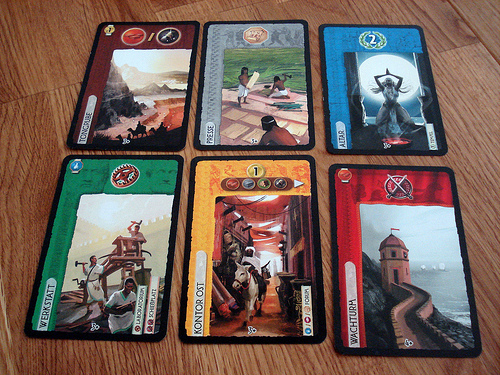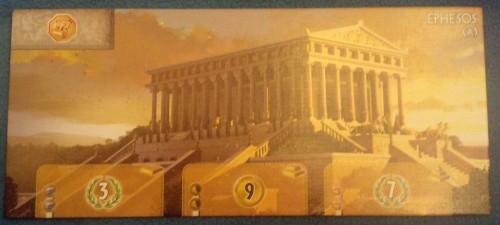Do you have a particular favorite ensemble crew, with disparate members, often coming from different backgrounds, all working together for a common cause? Think The Avengers, League of Extraordinary Gentlemen, or Bill & Ted’s Excellent Adventure (yeah, we went there). Or just watch The Ultimate Showdown. The menagerie idea isn’t unique, but they’re enjoyed because they represent people from very diverse origins coming together for a purposed goal. It’s a noble thought. At the same time, they tap into our personal attachments to one group or another. Here, we have the same idea. Here, we pit the seven most famous locations of the ancient Mediterranean against one another to determine which is the coolest. Admit it: you have a favorite too.
The Premise
Players in 7 Wonders take the reigns of one of seven famous ancient cities housing one of the Wonders of the Ancient World. Players will be leading their civilization as it progresses through time, watching their empire grow in a manner of their choosing. Players must accumulate resources, trade, build, fight, or inspire their way to victory and everlasting glory. All in about 45 minutes.
The Rules:
Unlike most civ-building games, and contrary to most people’s initial thought on the game, 7 Wonders is a fairly quick, fairly easy game to bring to the table. This is because 7 Wonders is not a board game, but a card game. Indeed, the only actual components besides the card decks themselves are the player boards, coins, and military VP markers. Setup, then, is very quick. Each player chooses from a set of randomizer cards to determine which ancient city they will be commanding. Each player board is double-sided, and the randomizer card specifies which side is to be used. Players also get three Coin to start.
Lastly, the decks of cards are arranged. The cards are separated into three numbered and color-coded Ages (Orange for Age I, Blue for Age II, and Purple for Age III). Cards in these sets are contingent on the number of players; any pertaining to a higher number than the number of players should be removed. (For example, if six players are playing, remove those specified for 7+). Additionally, remove the ten purple Guild cards from the Age III deck, and then randomly shuffle two more than the number of players worth into the Age III deck. (Again, if six players are playing, eight of the ten Guild cards will be used.) What should be left is seven cards per player per Age, and these are dealt are dealt out at the start of each Age.
Turns in 7 Wonders are taken simultaneously, in two steps. First, each player looks at the cards in their hand and chooses one to play. The rest are passed face-down to the next player for the following turn, and that direction switches during each Age. Each card is color-coded as to its purpose. Some cards make resources, while most provide Victory Points in some fashion at the end of the game.
Most cards, but not all, require a cost in order to play them. This is done through resources. Brown and Grey cards – along with Wonders – generate these resources each turn. Players are always provided the maximum amount that can be generated each turn from their play area, but resources do not carry over across turns. Instead, if players are short they can look to purchase missing resources from their adjacent neighbors for a cost. This does not impact that player’s resource pool either, but their own limits affect the amount of goods available to purchase through trade. (If they only have 2 Ore, you can’t purchase more than 2 Ore via trade with them.) Once a card can be paid for, it is played. In later Ages, various structures can be upgraded without cost if a player has the prerequisite structure.
As an alternative to playing cards, players also have two additional options. They can either discard the card face-down for 3 Coin, or they can pay the cost of the next stage in their Wonder’s progress and use the card face-down in that slot to unlock it. Regardless, each player only uses one card per turn. For each Age, on the sixth turn after selecting, the final card is discarded face-down instead. As a result, there are only 18 turns in the game. At the end of each Age, players compare their military strength with their adjacent players and collect positive or negative valued VP markers, depending on which side they came out on. After Ages I and II, the next deck of cards is dealt out, and play continues. The end of Age III ends the game. Players count up their score, calculating all the different types of cards in their tableau to determine their total value. The actual rule book goes into detail on how each card type is calculated. The player with the highest VP amount is declared the best architect of their civilization and the winner. The rest, to the oars with you.
History as an Afterthought
7 Wonders seems to be a a longer game at first glance because of the source material. Ancient cities? Steering a civilization? Usually, these things take time in a game. (We hear it’s substantially longer otherwise). Yet 7 Wonders is not your standard civ-building game. It makes sense giving the game’s creation.
| 7 Fun Facts About the Ancient Wonders |
|
The designer of the game, Antoine Bauza, the story goes, had a circle of gaming friends, and while they often could play smaller games, occasionally they had seven people at the table. Most gamers can attest that once you get over five or six participants, your options for non-party games drops substantially – and the time to play those left rises just as fast.
So, he set out to design a game that could handle seven people without becoming an all-weekend affair. He figured out the mechanics he wanted, and he surmised that a game using simultaneous play would solve his time issue. It wasn’t until after the skeleton was formed when he stumbled onto the idea of the Ancient Wonders theme.
That being said, from a thematic standpoint, 7 Wonders still delivers. Each of the Wonders subtlety but adequately reflects the civilization of that city. For example, it makes sense that the Great Pyramid only provides you with victory points (they just sit there), and that the Temple of Artemis awards you currency. Plus, you genuinely feel like you have a say in your city’s advancement through time due to your decisions.
For those looking for a more in-depth feeling, however, they may be left wanting. Immersionists will want to approach this one carefully, because while it has a lot to offer flavor-wise, it likely won’t scratch that world exploring itch some desire in their games.
Because the inception of the game wasn’t initially the theme, the normal constraints of a civ game don’t really apply to 7 Wonders. Rather than having to worry about many options, the designer implemented the card drafting concept, which significantly reduces downtime with players. It isn’t common to find substantive games where the time to play is independent of the number of players, and this has proven to be one of its central selling points.
But the game’s creativity doesn’t end there. Rather than having physical resources to manage, he opted for a representative pool of resources. In addition to cutting down on cost and valuable table space, it makes keeping track of resources simple and lets the game move forward at a decent pace. If anything, sometimes the game feels like it ends too soon, which is certainly a testament that players are engaged and interested in what they are doing. With this game, you won’t run into many players just sitting there waiting for the game to end.
The only real road block in terms of gameplay is at the very end. Calculating your score takes a little bit of effort – so much so that they provide a handy sheet to do the tallies on. It’s a straight-forward process, but it does feel a bit odd when you are playing at once speed, and then the tempo changes only at the very end to determine the winner. As this is relatively minor – and the only mechanical complaint – that certainly says something about the game’s worthiness.
Living Up To The Hype
When 7 Wonders came out in 2010, there was a lot of hype surrounding it, and many were skeptical. As it has percolated through the gaming community over the last few years, it’s become clear that it lived up to the attention it was given, culminating in receiving the very first Kennerspiel des Jahres award more complex games in 2011. The game’s flexible support for larger groups and modest play time, while not sacrificing strategy, is a key component of that success. Indeed, once a player overcomes the initial learning experience, subsequent sessions are concise and enjoyable.
To that end, if a Socializer can handle that minor hurdle, they should actually enjoy this game. After all, they’ll get the social interaction of being at the table without having to focus to heavily on what other people are doing. Of course though, it doesn’t hurt to pay attention.
Technically, the game is random enough to not even need a set strategy. Considering almost everything in the game provides you victory points in some way, it is actually possible to do decently just playing whatever you wish. Daredevils, have at it. The game certainly does have strategy, but it never becomes encumbered by it. 7 Wonders strikes a pleasing balance between working towards your objective without being bogged down in complexity.
For Tacticians and Architects, they’ll strive for more. The best strategies involve mixing diversity with a focus in a few key areas, and this plays into both archetype interests. Architects will enjoy building their resources and society up they way they desire, with little intrusion. They may not reach the heights that players reach in longer civ-based games, but it will be satisfactory all the same.
Tacticians will be happy with 7 Wonders for similar reasons. They get to work on whatever path to victory they’ve chosen without much interference – which is one way to keep a good Tactician in check. In this game, it is the limitation of scope that will keep them grounded instead. You only have so many rounds, so many cards, people can see what you are working on, and your sphere of influence extends about as far as your arms. As a result, their strategies won’t win any Rube Goldberg awards, but it’ll be sufficient for most in this group. Only the most die-hard strategist wing of the Tactican class may wind up feeling stifled after several sessions.
Strikers, like the Immersionists, are another group that may experience middling feelings with this game. On the one hand, players can test their strategic merits against others by trying to build the most efficient empire. After all, the game does have a finite goal and set rounds to base your decisions around.
On the other hand, there is no direct confrontation in this game. In fact, you don’t interact much at all with players not immediately adjacent to you. Even stockpiling military strength is only a means to get some victory points and doesn’t adversely affect your neighbors – although many players do get hung up on amassing a sizable army. As it stands, the most you can achieve is a passive conflict, whereby you may discard a card for coin you know that another player would really want, or use it towards your own Wonder, burying its secrets for all time.
The Takeaway
7 Wonders is not an award-winning game by accident. It encapsulates the feel of a heartier civ-builder while still being approachable for new players. And it’s playable in a short window of time. Because of this, it satisfies the needs of both experienced and inexperienced players alike. The randomness factor of the card draft mechanics and multiple paths to victory prove to be the great equalizing factors, keeping everyone on relatively equal footing. As a result, 7 Wonders is a great Post-Gateway game, whether you’re playing with two people or seven. It can be good for a family game or part of a game night ensemble with much success, and is certainly a decent addition to one’s collection. 7 Wonders has garnered quite a few accolades in its short lifespan, and we’re not one to argue with history here.
Cardboard Republic Snapshot Scoring (Based on scale of 5):
Artwork: 4
Rules Clarity: 5
Replay Value: 4
Physical Quality 3.5
Overall Score: 4



